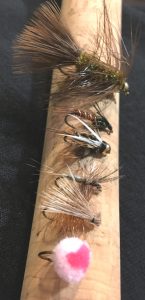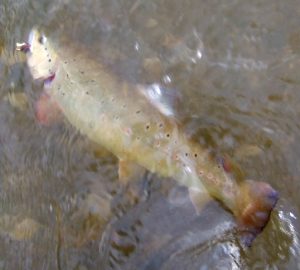By Nick Simonson
As the ice fades from white, to blue, to black to open water, one of the first species available for anglers throughout the region are the trout in the scattered streams and lakes of the upper Midwest. Whether it’s stocked browns in the Redwood River of southwestern Minnesota or rainbows in the Turtle River of North Dakota, or those that occur naturally on north shore streams of Lake Superior, fly fishing for these species of salmonids is a popular pursuit as soon as the ice moves out and the seasons open. It doesn’t take much to get connected with trout on the long rod in the upper Midwest, where fly fishing isn’t as technical and hatch-dependent as in western streams and a handful of flies will do the trick.
 1. The Woolly Bugger. Imitating just about anything that lives underwater – a leech, a crayfish, or small minnow – the woolly bugger can be worked slowly or stripped quickly through the column to draw the attention of hungry trout that haven’t seen a big bite to eat under the ice all season, or to trigger the feeding response in those stockers that have been preying upon pellets all winter at the hatchery. Tie or buy a half dozen in black, olive, and brown and add a couple bright ones in pink or orange for a well-rounded set of streamers. Make a couple of them bead-head models to add some flash and weight.
1. The Woolly Bugger. Imitating just about anything that lives underwater – a leech, a crayfish, or small minnow – the woolly bugger can be worked slowly or stripped quickly through the column to draw the attention of hungry trout that haven’t seen a big bite to eat under the ice all season, or to trigger the feeding response in those stockers that have been preying upon pellets all winter at the hatchery. Tie or buy a half dozen in black, olive, and brown and add a couple bright ones in pink or orange for a well-rounded set of streamers. Make a couple of them bead-head models to add some flash and weight.
2. Pheasant Tail Nymph. Falling into that half-inch, brown and buggy category that many successful flies do, this imitator of the mayfly’s aquatic stage is a staple for anyone starting out in fly fishing. Its many variants – bead head, hot butt, soft hackled and more – provide interesting tweaks to the popular pattern, but a dozen standard offerings in sizes 12 and 14 are an important cornerstone of any fly selection. Drift them through likely holding spots on streams and use a sinking line to explore the depths of trout lakes to present a tried-and-true offering.
3. Prince Nymph. Relying on a shimmery body of peacock herl, along with some tinsel ribbing, the prince nymph provides a bulky bit of something lifelike for trout to key in on in spring. The goose biot tail and wing gives off a stonefly nymph vibe, and the hackle collar pulses in the water. Add a bead head, vary the collar feather or change the color of the body to offer up something different and find confidence hues that trout can’t resist.
4. Adams. The Adams dry fly is a great search pattern in spring, and while designed to imitate a mayfly, when presented in smaller sizes, it can pass for a gnat or other small spring insects that hatch early in the season. With its thick hackle collar and feather wings, it floats well and is easy to see on the surface. In the evenings, stocked trout will rise to it as it rests on the water and stream trout will find it hard to pass up as it floats by.
5. Elk Hair Caddis. With its buoyant wing comprised of elk hair fibers and tight wraps of hackle underneath, the elk hair caddis shines as stocked trout settle in to their lake environs and begin keying on shoreline hatches of caddisflies in late spring. Easily converted to any color of the many species in the region, the EHC can be dressed with dyed hair or colored with a permanent marker in a pinch. When stocked trout have become accustomed to their water, catch their attention on calm mornings and evenings near shore by stripping this fly across the surface and wait for that surprising splash-and-take that makes dry fly fishing so much fun.
6. Glo Bug (Honorable Mention). The glo bug gets an honorable mention on this list for anyone headed north to take on the hard-charging steelhead of Minnesota’s north shore this spring; that and it’s so much fun to tie. Simply secure a stretch of yarn, like McFly Foam, to a hook, pull up and snip and the fly takes the shape of a fish egg that spawning chromers feed on from the start of the sucker spawn until late spring when their own run is complete. Fish it on sinking line, or behind a splitshot or a slinky sinker, to get it down near the bottom where trout are holding and let it drift through an area.
This handful of flies will have any angler set to take on trout in the upper Midwest this spring, whether they’re wild or stocked. Stash a selection of each offering and be ready to find fish any stream or still water…in our outdoors.
